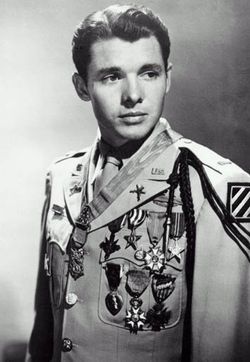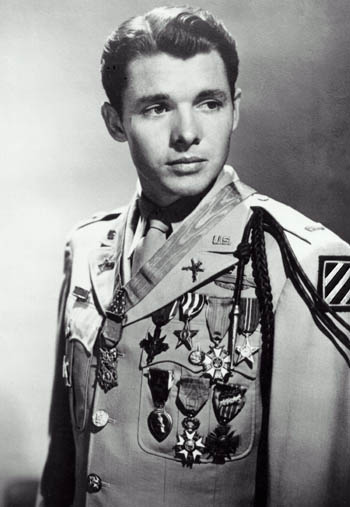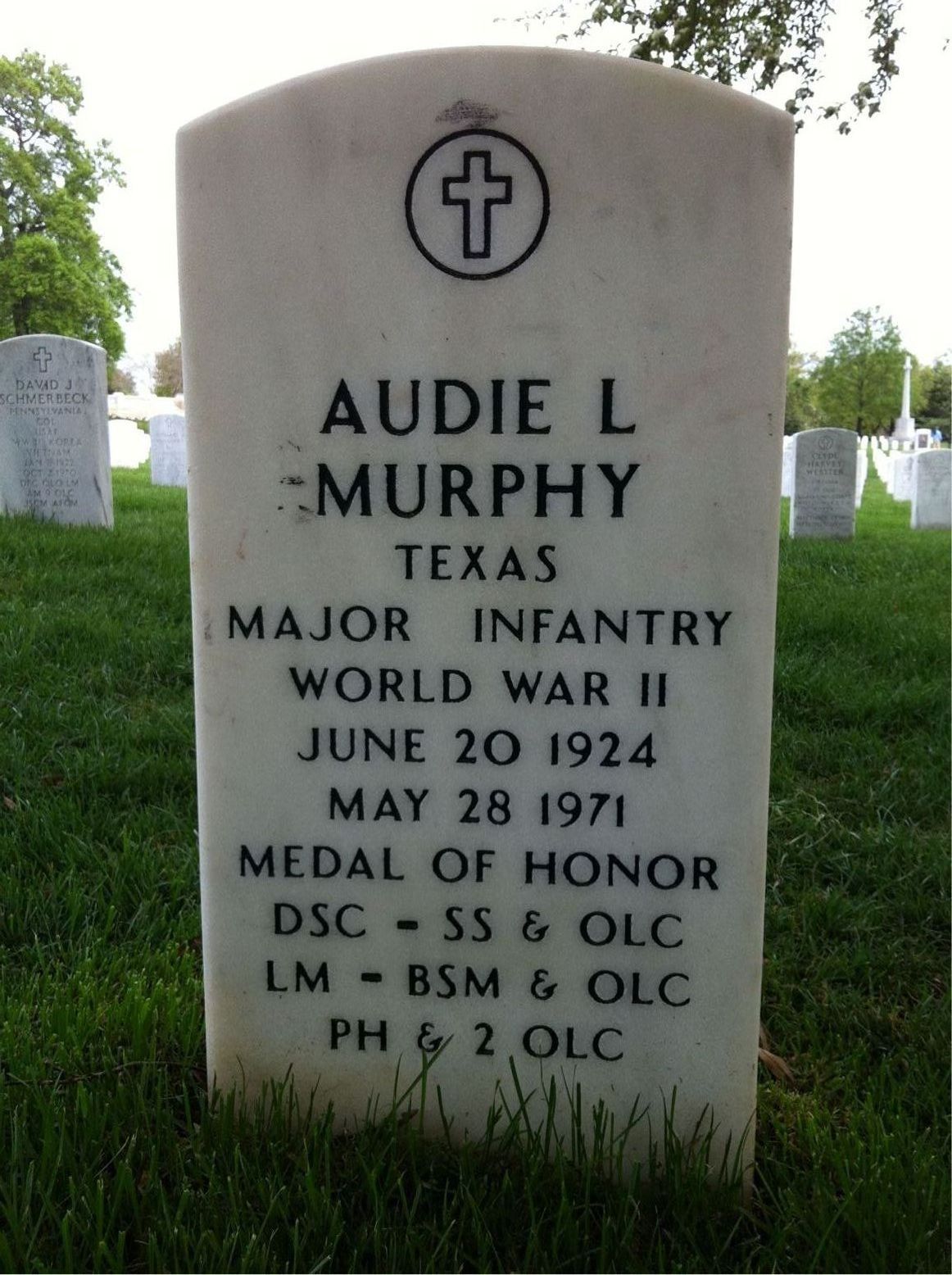World War II Medal of Honor recipient, Actor, and Songwriter. Arguably the most famous American field combat soldier to emerge from World War II, he served in Europe in the United States Army as a Second Lieutenant of Company B, 15th Infantry, 3rd Infantry Division. He was awarded the Congressional Medal of Honor for his bravery near Holtzwihr, France, on January 26, 1945. His Citation reads: "2nd Lt. Murphy commanded Company B, which was attacked by 6 tanks and waves of infantry. 2nd Lt. Murphy ordered his men to withdraw to prepared positions in a woods, while he remained forward at his command post and continued to give fire directions to the artillery by telephone. Behind him, to his right, one of our tank destroyers received a direct hit and began to burn. Its crew withdrew to the woods. 2nd Lt. Murphy continued to direct artillery fire which killed large numbers of the advancing enemy infantry. With the enemy tanks abreast of his position, 2nd Lt. Murphy climbed on the burning tank destroyer, which was in danger of blowing up at any moment, and employed its .50 caliber machine gun against the enemy. He was alone and exposed to German fire from 3 sides, but his deadly fire killed dozens of Germans and caused their infantry attack to waver. The enemy tanks, losing infantry support, began to fall back. For an hour, the Germans tried every available weapon to eliminate 2nd Lt. Murphy, but he continued to hold his position and wiped out a squad which was trying to creep up unnoticed on his right flank. Germans reached as close as 10 yards, only to be mowed down by his fire. He received a leg wound, but ignored it and continued the single-handed fight until his ammunition was exhausted. He then made his way to his company, refused medical attention, and organized the company in a counterattack which forced the Germans to withdraw. His directing of artillery fire wiped out many of the enemy; he killed or wounded about 50. 2nd Lt. Murphy's indomitable courage and his refusal to give an inch of ground saved his company from possible encirclement and destruction, and enabled it to hold the woods which had been the enemy's objective." His medal was issued on August 9, 1945. His war-time efforts won him promotions up to Major, in the U.S. Army. At the time of his discharge, he was the most decorated American soldier of the War, garnering 27 different medals (5 each from France and Belgium). Murphy received every U.S. military combat award for valor available from the U.S. Army. In addition to the Medal of Honor, he was awarded the Distinguished Service Cross, The Legion of Merit, 3 Purple Hearts, 2 Silver Stars with Oak Leaf Cluster, 2 Bronze Stars with Oak Leaf Cluster, as well as numerous campaign medals. After the war, he found a measure of stardom as a motion picture actor and played himself in "To Hell and Back" in 1955, which detailed his exploits. He also starred in the critically acclaimed 1951 movie version of author Stephen Crane's "The Red Badge of Courage." In all, he appeared in 47 films, most of them either Westerns or War movies. Despite his acclaim, his experiences in World War II haunted him for the rest of his life, and he was plagued by depression and insomnia, as well as financial troubles. His status as the "Most Decorated Soldier" from World War II never brought him any happiness, and he often commented that so many other soldiers should have gotten medals, but never did, because they gave their lives in the war. He died in a plane crash in Virginia after completing his last film "A Time for Dying." Buried with full military honors in a section near the Tomb of the Unknowns, his grave attracted so many visitors that a special walkway was built. When all the Medal of Honor recipients buried in Arlington had their headstones replaced with the now-standard Gold Leaf inlay Medal of Honor marker, his family requested that his be kept plain and inconspicuous, in accordance with his wishes. In the year 2000, the United States Postal Service honored him on a postage stamp.
View memorial site here.
World War II Medal of Honor recipient, Actor, and Songwriter. Arguably the most famous American field combat soldier to emerge from World War II, he served in Europe in the United States Army as a Second Lieutenant of Company B, 15th Infantry, 3rd Infantry Division. He was awarded the Congressional Medal of Honor for his bravery near Holtzwihr, France, on January 26, 1945. His Citation reads: "2nd Lt. Murphy commanded Company B, which was attacked by 6 tanks and waves of infantry. 2nd Lt. Murphy ordered his men to withdraw to prepared positions in a woods, while he remained forward at his command post and continued to give fire directions to the artillery by telephone. Behind him, to his right, one of our tank destroyers received a direct hit and began to burn. Its crew withdrew to the woods. 2nd Lt. Murphy continued to direct artillery fire which killed large numbers of the advancing enemy infantry. With the enemy tanks abreast of his position, 2nd Lt. Murphy climbed on the burning tank destroyer, which was in danger of blowing up at any moment, and employed its .50 caliber machine gun against the enemy. He was alone and exposed to German fire from 3 sides, but his deadly fire killed dozens of Germans and caused their infantry attack to waver. The enemy tanks, losing infantry support, began to fall back. For an hour, the Germans tried every available weapon to eliminate 2nd Lt. Murphy, but he continued to hold his position and wiped out a squad which was trying to creep up unnoticed on his right flank. Germans reached as close as 10 yards, only to be mowed down by his fire. He received a leg wound, but ignored it and continued the single-handed fight until his ammunition was exhausted. He then made his way to his company, refused medical attention, and organized the company in a counterattack which forced the Germans to withdraw. His directing of artillery fire wiped out many of the enemy; he killed or wounded about 50. 2nd Lt. Murphy's indomitable courage and his refusal to give an inch of ground saved his company from possible encirclement and destruction, and enabled it to hold the woods which had been the enemy's objective." His medal was issued on August 9, 1945. His war-time efforts won him promotions up to Major, in the U.S. Army. At the time of his discharge, he was the most decorated American soldier of the War, garnering 27 different medals (5 each from France and Belgium). Murphy received every U.S. military combat award for valor available from the U.S. Army. In addition to the Medal of Honor, he was awarded the Distinguished Service Cross, The Legion of Merit, 3 Purple Hearts, 2 Silver Stars with Oak Leaf Cluster, 2 Bronze Stars with Oak Leaf Cluster, as well as numerous campaign medals. After the war, he found a measure of stardom as a motion picture actor and played himself in "To Hell and Back" in 1955, which detailed his exploits. He also starred in the critically acclaimed 1951 movie version of author Stephen Crane's "The Red Badge of Courage." In all, he appeared in 47 films, most of them either Westerns or War movies. Despite his acclaim, his experiences in World War II haunted him for the rest of his life, and he was plagued by depression and insomnia, as well as financial troubles. His status as the "Most Decorated Soldier" from World War II never brought him any happiness, and he often commented that so many other soldiers should have gotten medals, but never did, because they gave their lives in the war. He died in a plane crash in Virginia after completing his last film "A Time for Dying." Buried with full military honors in a section near the Tomb of the Unknowns, his grave attracted so many visitors that a special walkway was built. When all the Medal of Honor recipients buried in Arlington had their headstones replaced with the now-standard Gold Leaf inlay Medal of Honor marker, his family requested that his be kept plain and inconspicuous, in accordance with his wishes. In the year 2000, the United States Postal Service honored him on a postage stamp.
View memorial site here.
Bio by: RPD2
Inscription
Texas
Major
Infantry
US Army
World War II
Medal Of Honor
Distinguished Service Cross
Silver Star & Oak Leaf Cluster
Legion of Merit
Bronze Star Medal & Oak Leaf Cluster
Purple Heart & 2 Oak Leaf Clusters
Family Members
-
![]()
Elizabeth Corinne Murphy Burns
1910–1980
-
![]()
Charlston Emmett "Buck or Charlie" Murphy
1912–1991
-
![]()
Vernon C. Murphy
1916–1920
-
![]()
Ariel June Murphy Van Cleve
1919–2001
-
![]()
Richard Houston Murphy
1926–1956
-
![]()
CPL Eugene Porter "Gene" Murphy
1927–2001
-
![]()
Veda Nadene "Veede and Deni" Murphy
1931–2023
-
![]()
Billie Beatrice "Bea" Murphy Bonner
1933–2004
-
![]()
SP5 Joseph Preston "Joe" Murphy
1935–1968
Advertisement
See more Murphy memorials in:
Records on Ancestry
Sponsored by Ancestry
Advertisement
















